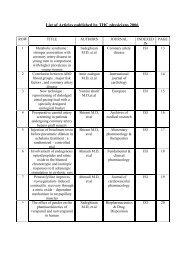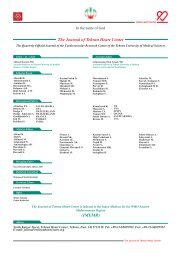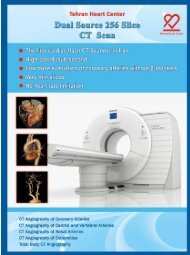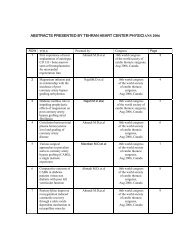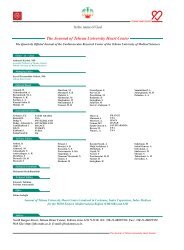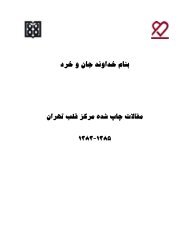THE JOURNAL OF TEHRAN UNIVERSITY HEART CENTER
THE JOURNAL OF TEHRAN UNIVERSITY HEART CENTER
THE JOURNAL OF TEHRAN UNIVERSITY HEART CENTER
You also want an ePaper? Increase the reach of your titles
YUMPU automatically turns print PDFs into web optimized ePapers that Google loves.
The Journal of Tehran University Heart Center<br />
Mahdi Najafi et al.<br />
Table 5. Predictors of length of stay at surgical ward in patients undergoing bypass surgery<br />
Univariate analysis<br />
Multivariate analysis<br />
OR 95% CI P value OR 95% CI P value<br />
Peripheral vascular disease 1.858 1.241-2.781 < 0.01 1.568 1.013-2.426 0.04<br />
HbA1c 1.268 1.133-1.419 < 0.01 1.210 1.074-1.362 < 0.01<br />
Last fasting blood sugar 1.011 1.006-1.016 < 0.01 1.009 1.003-1.014 < 0.01<br />
Inotropic drug use 1.566 1.071-2.291 0.02 1.638 1.088-2.465 0.02<br />
Postoperative arrhythmia 0.627 0.420-0.937 0.02 0.531 0.343-0.822 0.01<br />
Mean insulin intake within 24 hours after surgery * < 0.01 < 0.01<br />
1 vs. 0 2.462 1.525-3.973 2.455 1.487-4.054<br />
2 vs. 0 2.718 1.709-4.321 2.708 1.648-4.450<br />
*<br />
Group 0 = Zero U<br />
Group 1 = 1 to 9 U<br />
Group 2 ≥ 10 U<br />
OR, Odds ratio; CI, Confidence interval; NYHA, New York Heart Association; HbA1c, Glycosylated hemoglobin<br />
surgical ward was investigated through a comparison of the<br />
average ICU, surgical ward, and total hospital stay as well<br />
as in-hospital mortality rate between two groups of ICU stay<br />
( ≤ 48 and > 48 hours) as listed in Table 3. The overall inhospital<br />
mortality rate was 0.5%.<br />
In all the patients studied, the LOS at the cardiac surgical<br />
ward ranged from 1 to 14 days (mean ± SD, 2.73 ± 1.99<br />
days) with a median of 2 days. Patients with a prolonged<br />
surgical ward stay (144/570, 25.3%) were more likely to be<br />
women and have diabetes, family history of coronary artery<br />
disease, history of peripheral disease, and lower educational<br />
level.<br />
Table 4 compares the patients’ characteristics by taking<br />
into consideration the LOS in the ward after cardiac surgery.<br />
Among the important factors that were significantly different<br />
between the two groups, i.e. LOS > 3 days and LOS ≤ 3 days,<br />
five factors were independent predictors. Three predictors<br />
were indices of glycemic control (Table 5). The area under<br />
the Receiver Operating Characteristic Curve (AUC) was<br />
found to be 0.71, which showed a good predictive accuracy<br />
in the variables included in the model. The model was also<br />
found to fit the data well since the Hosmer-Lemeshow p<br />
value was 0.88 (p < 0.05 indicated a poor fit).<br />
Discussion<br />
In the current study, we included preoperative,<br />
intraoperative, and immediate postoperative variables to<br />
find LOS determinants in 570 CABG patients after bypass<br />
surgery. The six variables of intra-aortic balloon pump<br />
(IABP), NYHA functional class, postoperative arrhythmia,<br />
24-hour average insulin intake, mean 6-hour BE, and surgeon<br />
category were found to be the independent predictors of<br />
an ICU LOS greater than 48 hours. We also found five<br />
predictors to be the independent risk factors for an increased<br />
cardiac surgical ward LOS. Considerable reports have been<br />
published on the predictors of LOS in the ICU following<br />
CABG 4-12 and some studies have investigated factors<br />
increasing postoperative hospital stay. 13-16 To our knowledge,<br />
however, no study has focused on the determinants of the<br />
LOS of cardiac surgical wards. Thus, we think that our study<br />
may contribute to the literature in this regard.<br />
Over the past two decades, attempts have been made to find<br />
the determinants of postoperative LOS in CABG patients.<br />
Be that as it may, a great disparity in type and number of<br />
independent variables analyzed has been reported. Although<br />
most of outcome studies with the focus on LOS have<br />
investigated only preoperative and intraoperative variables,<br />
there are some outcome research reports with immediate<br />
6, 13<br />
postoperative variables included.<br />
Poor cardiac output states, as reflected by the need for<br />
an IABP and inotropic therapy, have been identified as a<br />
predictor of a prolonged ICU stay in several studies. 6, 8, 9 In<br />
the present study, use of IABP was an ICU stay predictor,<br />
whereas inotropic support was a surgical ward stay predictor.<br />
Additionally, both reflected cardiac output.<br />
Need for an IABP was identified as an independent<br />
risk factor for ICU stay longer than 48 hours in three<br />
studies. 18-20 In contrast, Doering et al. showed that only early<br />
hemodynamic instability was indicative of an ICU stay<br />
longer than 24 hours, whereas postoperative IABP and use<br />
of inotropic drugs were not. 9 Michalopoulos et al. also noted<br />
that the number of inotropes, rather than inotrope use itself,<br />
was the significant factor. 6<br />
These differences may result from different treatment<br />
protocols or the way in which variables such as the use of<br />
inotropes were defined. Michaloupolous et al. used a 6- hour<br />
window for starting inotropic support after surgery and did<br />
not consider vasodilators. 6 By contrast, in the Doering et al.<br />
study, a 3-hour period was adopted and after-load reducers<br />
such as nitroprusside were considered in the definition of<br />
inotropic support. 9 Christakis et al. did not consider inotropic<br />
support alone, adding to IABP support in defining low output<br />
state. 7<br />
Some disparities in study results may be due to various<br />
study populations and treatment protocols, different cut-offs<br />
used to define a prolonged stay in the ICU (from ≥ 2 to 10<br />
174



